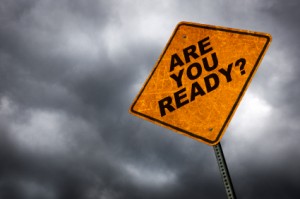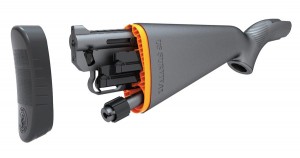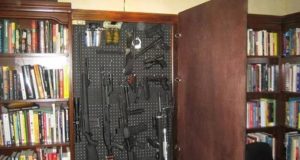“The end of the world as we know it” has been a popular and often oddly described event that many living off the grid have actually placed some importance on or at minimum have factored the idea into planning. And for many of these off-gridders, the “end of days” requires a firearm capable of meeting a variety of needs.
 What constitutes an end-of-days gun? Some would say the most firepower; others might say that which has the simplest and toughest design. There are enough opinions to take up a whole article without exploration, just denotation. The point here is to give you an idea of some guns which might not yet be on your radar, yet seem a legitimate choice for a gun which will invariably be asked to perform far beyond its pay scale.
What constitutes an end-of-days gun? Some would say the most firepower; others might say that which has the simplest and toughest design. There are enough opinions to take up a whole article without exploration, just denotation. The point here is to give you an idea of some guns which might not yet be on your radar, yet seem a legitimate choice for a gun which will invariably be asked to perform far beyond its pay scale.
It seems there is an overarching theme of world-changing events upcoming in the near future; whether you believe that zombies are coming or that the Mayan calendar got it right; whether you see the allusions to the biblical prophecies of Revelations in the everyday newscasts, or whether you have for many years realized that the type of world you live in is the type you prefer not to, everyone has some idea in their mind of what is to come. In almost all scenarios, it eventually gets pretty ugly.
So what does it take to get prepared for such an instance? Well you’ve already been a fan of the content on this site and realize how appropriate most of it is for such a scenario; you have some basic plans or are working towards them; you may even own a gun or two for hunting or home defense.
But of late, the cost of shooting and stockpiling ammunition has become prohibitive. With brass costs on the rise, heavier regulations than ever by regulatory agencies like the EPA and BATF, fear of a second term for our current president, and ever-increasing pressure on guns from the anti-gun lobby and the mainstream media, it has gotten difficult now to make a real storage plan for hunting, survival, or personal defense.
In all reality, whether you believe in zombies or not, some event is likely to occur which threatens to make “zombies” of much of the population, which in turn threatens you and your family. In all likelihood, there is a food shortage coming in the next several years, regardless of how much face value you place on the Mayan calendar.
I like to say less is more in my normal lifestyle, but in this case, and in the case of any extended scenario, more is more, and overstocked is better.
However, if you’re anything like me, you realize buying thousands of rounds of .300 Winchester Magnum isn’t as practical as it once was (note the sarcasm), and in a similar fashion, neither is buying up thousands of rounds of .45. Now don’t mix metaphors here: I will still have a good amount of those rounds on hand, as with any other caliber I use, but I need something that can be had in bulk, and for which I can use to satisfy a large portion of my “daily” gun tasks with. Absent a very good deal on military surplus ammunition, the only thing that truly comes to mind is a reliable and inexpensive, easy-to-supply-ammunition-for, .22LR. As a side note, if you don’t buy enough, you can forage for it, because this stuff practically grows on trees (relative to other ammunitions).
Even though the subject discussed here doesn’t compose the author’s total thoughts or preclude other options, it’s safe to say that this gun owner is in love with the .22LR. It’s cheap, abundant, easy for anyone to use, accurate enough, and has the potential to kill anything on earth, given the right circumstances. It simply does more work than it should do; it exceeds its perceived intrinsic value.
Because in a time of great chaos, it seems that off-gridders would focus on those things that are easily obtainable, easy to use, simple to understand, and create great value; thus, the .22LR fits in well. If you can handle the idea of using a .22LR in an off-the-grid and end-of-days scenario, you’d do well to take a look at this list.
How to hide your guns, and other off grid caches…
Everyone’s got one, every manufacturer makes one, and no one is afraid of one, but which one should you take a look at? Here are some semi-automatic .22s that might make sense if it gets past the point of no return in 2012.
Ruger 10-22 Takedown
It’s new in delivery, but has an old soul in terms of the original idea. It’s the one all the lovers of nature and Ruger 10-22s were waiting for. The 10-22 as a rifle itself is legendary, and for lack of a better term, awesome. It’s simple, easy to understand, built well, tough, and relatively inexpensive. Four out of five isn’t bad, considering the extra benefits you get by going with a takedown model. It is, unfortunately, lacking the Ruger-trademarked inexpensiveness. While you can most days find a Ruger 10-22 for under $225, this one will run you at least $365 (if you can find it in stock). That seems to defeat most of the idea of a cheap gun for the coming apocalypse, right? Wrong. In the grand scheme of things, $365 is a pittance when you look at the history of reliability, the availability to parts, and the overall low cost of ownership, not to mention the portability you gain with this version. It’s built tough and is made for the long haul. It’s deadly accurate, doesn’t feel cheap, and has a reputation for kicking you-know-what and taking names. It’s stainless steel, polymer, and ingenuity all wrapped up into one little compact package that weighs in at just under five pounds.
The Marlin 70 Papoose
The Papoose was Marlin’s answer to the Ruger 10-22 takedown, except it’s been around for years. It’s smaller, lighter, and cheaper than the Ruger 10-22 Takedown; it too has a stainless composition, but uses a single-stack magazine in lieu of the normal Ruger rotary magazine. The Papoose weighs about a little over three pounds and has a barrel two inches shorter than the Ruger barrel (the Papoose’s barrel is 16.5 inches long)
If you need to stay under the $300 mark and want a solid gun with a great reputation for being a workhorse, the Model 70 Marlin is right around $285 and has said reputation locked up, with many years in service.
Henry Repeating Arms AR-7
 If you want the original poster child for the compact semi-auto .22, the Henry AR-7 is the most current iteration of the original breakdown/takedown survival rifle.
If you want the original poster child for the compact semi-auto .22, the Henry AR-7 is the most current iteration of the original breakdown/takedown survival rifle.
It floats, carries all of its parts in the butt stock when not in use, and has a decent reputation considering its simplicity and lightweight.
It will cost you above $250 but usually less than $275 to get into an AR-7, and it is noticeably less hefty than the other two guns mentioned, in regards to its heavy usage. That isn’t an indication that the rifle isn’t up to the task of an end-of-days survival-type rifle (in fact, you can find our previous article on the Henry AR-7 here), simply that you lose a bit of bulk and heavy-duty workload capacity in favor of ease of use, simplicity, and functionality. If you get used to the gun, you’ll gladly carry it wherever you go, whether into the horde of “zombies” or into the woods in search of squirrel.
©2012 Off the Grid News
 Off The Grid News Better Ideas For Off The Grid Living
Off The Grid News Better Ideas For Off The Grid Living




